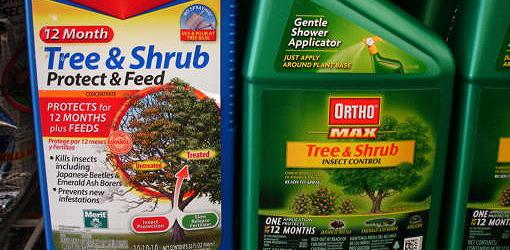
Hemlock trees add beauty and shade to yards and parks, but they face a serious threat from a tiny insect known as the hemlock woolly adelgid (HWA). This aphid-like pest is wreaking havoc on hemlock populations from Maine to Georgia, endangering both native forests and landscape trees. If you have hemlocks on your property, you should know how to remove and prevent HWA to keep your trees healthy and vibrant
Early detection and treatment are key to giving infested trees the best chance of recovery. This guide explores how to identify, prevent, and treat hemlock woolly adelgid infestations to help you protect your trees.
Understanding the Hemlock Woolly Adelgid
The hemlock woolly adelgid is a small but destructive insect that is a major concern for hemlock trees in the eastern United States. Originally from Asia, where it coexists harmlessly with native hemlock species, the adelgid has found North American hemlocks to be particularly vulnerable to its feeding habits.
Origin and Spread
The hemlock woolly adelgid was first discovered in the western United States in the 1920s. However, it didn’t pose a significant threat to western hemlock species. The real problem began when the adelgid made its way eastward, where it encountered eastern and Carolina hemlocks that had no natural defenses against this new pest.
Life Cycle and Feeding Habits
The adelgid has a complex life cycle that aligns with the growth patterns of hemlock trees:
- Spring: Orangey-brown eggs are laid
- Early summer: Tiny reddish-brown insects hatch and begin crawling on stems
- Summer: Young insects spin white, woolly nests at the base of needles
- Fall and winter: Adelgids emerge from dormancy and resume feeding
These insects feed on the sap at the base of hemlock needles, disrupting the tree’s ability to transport nutrients. Over time, this feeding can cause needle loss, branch dieback, and eventually, tree death if you don’t treat it.
Impact on Hemlock Ecosystems
The adelgid’s impact extends beyond individual trees. Hemlocks are a large part of the forest ecosystems—they are a habitat for wildlife and maintain cool, shaded conditions in riparian areas. The loss of hemlock populations can lead to significant changes in forest composition and function, affecting a wide range of plant and animal species.
How to Identify Hemlock Woolly Adelgid Infestations
Detecting a hemlock woolly adelgid infestation is the best for effective treatment. You should be vigilant and regularly inspect your hemlock trees for signs of these pests. Here are the key indicators of an adelgid infestation and when to look for them.
Visual Indicators
The most noticeable sign of a hemlock woolly adelgid infestation is the presence of small, white, woolly masses on the underside of hemlock branches, typically at the base of needles. These masses are the protective covering for the adelgid’s eggs and you can see them year-round, but they are most visible in spring and early summer.
Other signs to look for include:
- Needle discoloration (graying or browning)
- Needle loss
- Branch dieback, especially on lower branches
- Thinning of the tree’s crown
Look for the waxy nodules on the stems of hemlock trees.
Seasonal Inspection Guide
To best prevent infestations, you need monitor for hemlock woolly adelgid—do inspections throughout the year.
In the spring, look for new egg sacs and emerging nymphs. Once summer starts, check for crawling insects on branches. In the late summer months, be on the lookout for established woolly masses. Lastly, in the fall and winter, keep inspecting the trees, as adelgids remain active in cooler months.
Treatment Options for Hemlock Woolly Adelgid
There several treatment options you can use to treat for HWA. The choice of treatment depends on factors such as the severity of the infestation, the size and location of the trees, and environmental considerations. Here are the various treatment methods, from chemical controls to more natural approaches.
Chemical Treatments
Chemical treatments are often the most effective way to combat hemlock woolly adelgid infestations, especially for trees in home landscapes. However, it’s important to use these products carefully and follow all safety guidelines.
Examples of chemical treatment options for woolly adelgid on hemlock trees.
Soil Drenching
Soil drenching is one of the most effective methods for treating hemlock woolly adelgid in residential settings. To apply this treatment, choose an insecticide with the active ingredient Imidacloprid.
Then, dig a shallow trench around the tree, about one foot from the trunk. Mix the insecticide concentrate according to the package instructions and pour the mixture into the trench. This method can take several months to show results, but it provides long-lasting protection for the tree.
Foliar Sprays
For smaller hemlock trees, foliar sprays are an effective treatment option. Select an Imidacloprid-based spray product and apply the spray to all parts of the tree, including the undersides of branches. Give it thorough coverage to prevent missed areas that could harbor adelgids.
Foliar sprays offer quicker results than soil drenching but may require more frequent applications.
Natural and Less Toxic Options
If you want environmentally friendly solutions, here are alternatives to traditional chemical treatments.
Horticultural Oils and Insecticidal Soaps
These products can be effective against hemlock woolly adelgid while having less environmental impact. Apply dormant oil or insecticidal soap in the fall and give the tree complete coverage. Repeat treatments annually, as these products don’t provide long-term protection.
While less toxic, these treatments still require careful application and shouldn’t use them near water sources.
Biological Controls
Researchers are exploring using natural predators to control hemlock woolly adelgid populations. For example, predatory beetles are showing promise in large-scale control efforts.
Some species are commercially available for release in infested areas. If you’re interested in this option, consult with local extension offices for guidance.
While biological controls may not provide immediate results, they offer a sustainable, long-term approach to adelgid management.
Prevention and Ongoing Care
You can significantly reduce the risk of HWA infestation and improve their trees’ resilience with prevention methods. Here are the top prevention strategies and maintenance tips to keep your hemlocks healthy and adelgid-free.
Watering and Fertilization
Proper watering and fertilization strengthen hemlocks and make them less susceptible to adelgid infestations. Make sure you give your hemlocks plenty of water, especially during dry periods. Apply mulch around the base of trees to retain moisture and regulate soil temperature.
Avoid over-fertilization, which can make trees more attractive to pests. Also, prune dead or dying branches to improve air circulation and tree health.
Regular Monitoring
Inspect your hemlock trees at least twice a year, focusing on new growth. Look for signs of stress or decline that could make trees more vulnerable and keep records of inspections and any treatments you apply.
If you don’t treat it, branches infected by woolly adelgids die.
Quarantine Measures
To prevent the spread of hemlock woolly adelgid, avoid moving potentially infested plant material. Clean your equipment and clothing after working in infested areas. Additionally, only purchase hemlock trees from reputable sources that certify their stock as adelgid-free.
When to Get Professional Help
While homeowners can apply many hemlock woolly adelgid treatments themselves, there are situations where professional assistance is necessary or beneficial. Here’s when we recommend calling pest control professionals for help:
- Large or mature trees that are difficult to treat without specialized equipment
- Severe infestations that have caused significant damage to the tree
- Trees located near water sources, where chemical treatments require extra care
- When biological control methods are desired, as these often require expert knowledge









Leave a Reply